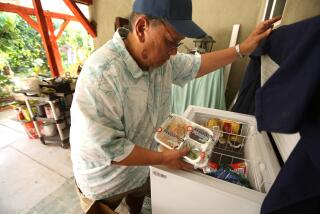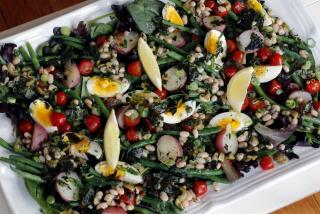Menus Meet Caloric Needs of the Aging
- Share via
Many people assume that dining in old age means lots of applesauce, mashed potatoes and pureed meat.
This is simply not the case.
It is true that as we age our bodies becomes less efficent at performing what were once considered normal tasks. Still, many elderly people are capable of living very much as they did when they were 10 or even 20 years younger. And, says Gail Frank, professor of nutrition at Cal State Long Beach, food can continue to be a source of comfort. “The good life is possible as we age,” she says, “but we must be wise about what we eat.”
There is a paradox that comes with aging. As we grow older, our metabolism slows down tremendously so that the amount of food we require for fuel declines. At the same time, nutrient needs increase.
While a daily intake of 1,400 calories might be considered a reducing diet for a 25-year-old woman, for her 70-year-old mother it would be nothing more than a standard diet. This makes it particularly difficult for seniors to get all the nutrients they need. For example, many older people eat diets deficient in calcium, and inadequate calcium is a leading cause of deficiency-related deaths in elderly women.
To increase the amount of calcium in the diet, Frank recommends using nonfat dry milk as an extender in meat patties, turkey burgers, mashed potates, casseroles and baked goods.
Stirring milk solids into fluid milk will boost the calcium content of the beverage for drinking and for cooking. Use 1/2 cup nonfat dry milk solids for every 2 cups milk.
Digestion can be a problem as we grow older: Increasing the frequency of meals is one way to relieve this. Frequent meals can also help with constipation, another complaint.
“Several small feedings are more appropriate than large meals,” said Frank. “It may be better to have three small meals and three moderate snacks--half a protien-rich sandwich, cooked fruit, dairy product and starch or low sugar dessert. And they should be spaced so that every four hours there is something coming into the stomach. This way, intestine and (digestive) juices aren’t overwhelmed with a large volume of food. Plus, they have a smaller amount (of food) to interract with. This aids the absorption.”
In general, menus designed to meet the nutrient and physiological needs of the older adult can be similar to those selected for growing children, said Dr. Loren Lipson, chief of Geriatric Medicine, USC School of Medicine. He and Frank both agree that older adults, like growing teens, can benefit from a multivitamin supplement. It can make up for nutrient loss due to absorption problems, intake decline and drug interractions.
“Consider current physical state,” Frank said. “If older people are not able to manipulate or chew as well then we must alter the texture but we should still maintain the nutrient density (of the foods they eat). The elder person has to realize and accept that he may have to go to steamed or chopped foods more often . . . but eating is one of the areas in their lives where they can still maintain control.”
Here are three days of menus adapted from the Phase 1 eating plan outlined in the book “The New American Diet” by Sonja L. Connor, a registered dietitian and William E. Connor, MD (Simon and Schuster: $12.95). The plan features a cholesterol intake of about 300 of 350 milligrams per day. Fat content is around 35%. Carbohydrates are increased in the diet to fill in for fat and provide extra fiber.
DAY 1
BREAKFAST
1 1/2 cups whole strawberries
1 cup cold whole - wheat cereal
1 teaspoon sugar
1 cup nonfat milk
1 slice rye toast
1 teaspoon soft margarine
LUNCH
Soft tostada:
1 (6-inch) corn tortilla, steamed
1/4 cup refried beans
1 ounce cooked lean ground beef
1 1/2 ounces lowfat cheese
1/4 cup shredded lettuce
1 tablespoon chopped tomato
1 apple
AFTERNOON SNACK
1 brownie
DINNER
3 ounces Sauteed Chicken With Mushrooms
1/2 cup whole kernel corn
1/2 tomato, sliced
1/2 cup mashed potatoes or 1 small baked potato
EVENING SNACK
1 cup fruit gelatin salad
DAY 2
BREAKFAST
3/4 cup orange juice
2 pieces French toast
1/4 cup syrup
2 teaspoons soft margarine
LUNCH
Laura’s Refrigerator Chicken Salad on salad greens
1 cup onion soup
DINNER
3-inch serving lasagne from lean ground beef, part-skim mozzarella and cottage cheeses
1 cup tossed green salad
3 tablespoons reduced calorie dressing
1 large sourdough roll
2 teaspoons soft margarine
1 cup fresh fruit salad
DAY 3
BREAKFAST
1/2 cup apple juice
3 (4-inch) buttermilk or oat bran pancakes
1/4 cup syrup
2 teaspoons soft margarine
LUNCH
1 serving Mediterranean Lentil Salad
1 3-inch piece cornbread
2 teaspoons soft margarine
1 orange
DINNER
1 cup macaroni and cheese, made with lowfat cheese
3/4 cup steamed broccoli
1 dinner roll
EVENING SNACK
3/4 cup rainbow sherbet
LAURA’S REFRIGERATOR CHICKEN SALAD
1 medium chicken, cooked, skinned and shredded
1 large tomato, chopped and well drained
1 sweet yellow pepper, coarsely chopped
2 carrots, peeled and shredded
1/2 head romaine lettuce, coarsely chopped
2 1/4 ounces slivered almonds
15 Chinese pea pods, cut julienne
1/2 teaspoon minced ginger root
3 green onions, chopped
2 teaspoons toasted sesame seeds
1/2 tablespoon Dijon mustard
1 teaspoon sesame oil
1/2 cup reduced-calorie mayonnaise
Salt, pepper
Combine chicken, tomato, yellow pepper, carrots, lettuce, almonds, pea pods, ginger, green onions and sesame seeds in large bowl.
In separate bowl, combine Dijon mustard, sesame oil and mayonnaise. Mix well and season to taste with salt and pepper. Gently toss dressing with chicken mixture until thoroughly coated. Makes 6 servings.
MEDITERRANEAN LENTIL SALAD
(“American Cancer
Society Cookbook”)
1 cup brown or green lentils
1 cup diced peeled carrots
1 cup diced red onion
2 cloves garlic, minced
1 bay leaf
1/2 teaspoon dried thyme
2 tablespoons olive oil
2 tablespoons lemon juice
1/2 cup diced celery
1/4 cup chopped parsley
1 teaspoon salt
1/4 teaspoon black pepper
Combine lentils, carrots, red onion, garlic, bay leaf and thyme in saucepan. Add enough water to cover by at least 1 inch. Bring to boil, then reduce heat and simmer, uncovered, until lentils are tender but not mushy, 15 to 20 minutes. Drain and remove bay leaf.
Add olive oil, lemon juice, celery, parsley, salt and pepper. Toss to mix. Serve at room temperature. Makes 8 servings.
More to Read
Eat your way across L.A.
Get our weekly Tasting Notes newsletter for reviews, news and more.
You may occasionally receive promotional content from the Los Angeles Times.










